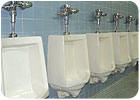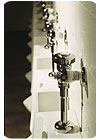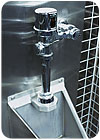
Call it unfair, if you will. When it comes to restroom design, there are simply some basic advantages to being a man. But it’s the facility managers and owners who gain the most from nature’s differences when they flex their water-efficient plumbing fixture options in the men’s room.
Of course, there are plenty of water-efficient equalizers in public restrooms and locker rooms; faucets, water closets and showerheads offer similar savings, whether they’re serving men or women. No fixture but the urinal, however, can manage the swing from 3.5 gpf/13.2 lpf all the way down to little or zero water consumption - all while requiring no change in user behavior or fixture performance compromise to gain the water savings.
The average urinal water consumption ranges from 1.0 gpf/3.8 lpf to 1.5 gpf/5.7 lpf. There are urinal flushometers that consume as much as 3.5 gpf/13.2 lpf, which is necessary for specialized applications.
As a result of the U.S. Energy Policy Act of 1992, which prohibits the use of excessive water-wasting fixtures, urinals consuming less water have been available for at least 15 years, and manufacturers are continually developing more water-efficient fixtures. Urinals are emerging on the market that can effectively and hygienically operate at 0.25-gpf flush levels or even lower.
This past spring, the first 0.25-gpf vitreous china urinal was introduced to the North American market. This water consumption level falls within the EPA’s definition of high-efficiency urinals (HEU) that use a maximum of 0.5 gpf/1.9 lpf. (For more information on the EPA’s Energy Star and WaterSense programs, go to www.epa.gov/WaterSense.)
Waterfree urinals also are grouped under the HEU category, and needless to say, you can’t get any better than 100 percent water savings. Just as the industry has come to realize that water-using urinals can operate very well using only a fraction of the amount of water that they did in years past, minds are changing quickly in favor of waterfree urinals.
Care and maintenance for waterfree urinals differ from flush valve models: Waterfree urinals typically use a disposable cartridge or some other sort of liquid barrier to isolate the restroom area from the sewer gases, and the liquid barrier allows the liquid waste to pass through into a standard drain line. The liquid barrier needs to be maintained after every 6,000 to 7,000 uses, as the liquid barrier tends to wick out to the drain line at each use. It’s up to maintenance personnel to replenish the liquid barrier by either switching out cartridges on a scheduled routine or replacing as needed, depending on the amount of restroom traffic.
Waterfree urinals should be cleaned in accordance with the manufacturer's instructions.

Calculating Fixture Replacement
Most facility owners and managers are open to installing water-efficient fixtures - as long as they come out on top financially. So when does it make better dollar sense to replace higher water-consuming urinals with more efficient models? Naturally, water and money savings are exponentially greater as the consumption level of the existing fixtures rises and the water consumption level of the proposed fixture to be installed falls. Each facility should do its homework, however, to calculate usage and the potential cost savings of installing high-efficiency urinals.Consider an office building with four urinals flushing an average of 100 times per day during a 260-day work year. Consider the local combined water/wastewater cost as being $4 per 1,000 gallons. According to figures by the U.S. Department of Energy’s Federal Energy Management Program, the annual water/wastewater cost would be $364 if the urinals were 3.5-gpf models, $156 for 1.5-gpf models, $104 for 1.0-gpf models, and $52 for 0.5-gpf models.
Replacing 3.5-gpf models with 0.5- gpf flush valves (assuming the vitreous china fixtures remain), costing an average of $200 apiece, would pay off in less than three years. It would be a tougher sell to suggest replacing 1.5-gpf models with 0.5-gpf models, because it would take about 10 years before the water/wastewater cost savings would offset the initial fixture purchase and the real savings would begin.
The payoff with waterfree urinals, on the other hand, can be substantial. Four 1.5-gpf urinals in the example above would have an annual water/wastewater cost of $156 compared to no water or wastewater cost for the waterfree urinals. The payoff for replacement (with waterfree urinal models costing $400 apiece) would come in about eight years, even when the cost of purchasing replaceable cartridges for the waterfree urinals is included. After that period, the savings really add up.

When Standing In Line Pays Off
Some manufacturers also have special built-in features on conventional urinals that can make urinals more water efficient, such as technology that regulates water usage. For men’s restrooms in stadiums, sports arenas and other facilities that experience large, periodic rushes of users, some sensor-operated urinal flushometers can be set to flush only at pre-determined intervals and not after every single use, or to vary the water volume from flush to flush.Either of these high-volume flush modes remains in effect as long as the sensor detects a continuous line of users, commonly referred to as a queue of users waiting to be serviced. A sensor can typically detect two body positions out in a line to maintain the user high-use reduced-flush mode feature. Once the queue is broken, the flushometer resets to regular flush mode, ready to continue in high-use mode when a new queue forms.
The main benefit of these high-use flush settings is reduced water usage, which results in lower water and wastewater utility bills. Urinals that already consume as little as 0.5 gpf for regular operation can use much less water overall when equipped with a high-use flush mode feature.
There are two basic types of high-use flushing modes: staggered flushing (also known as stadium flush) and per cycle reduced-volume flushing.
Staggered flushing triggers a flush only after the sensor detects that a certain number of users, usually about five, are queued in line. The reduced-volume mode flushes after each user, but the water volume varies each flush; a low-volume flush for several users in a queue, for example, may be followed by one full-volume, cleansing flush. Then the low-volume cycle restarts. The flushing volume per queued user progressively decreases.
Engineers compared these two high-use flush modes to determine how much water is saved. They found that staggered urinal flushing uses much less water than reduced-volume flushing when there’s a long queue. In fact, the longer the queue, the more water that a staggered flush mode will save. Although the reduced-volume flush mode is using less water for most of its flushes than the staggered flushing mode, it’s still flushing after every user.
For a continuous queue of 15 users, the reduced-volume flush mode would typically have a 0.5-gpf flush after users 1, 10 and 15; after all other users, there would be a 0.3-gpf flush. The staggered flush mode, on the other hand, would trigger a 0.5-gpf flush after users 5, 10 and 15; there would be no flush after all other users until the queue was broken.
In this example, the staggered flush mode would use only 1.5 gallons of water, whereas the reduced-volume flush mode would consume a total of 5.1 gallons (see Figure 1).
Both high-use modes, however, are improvements over a regular flush mode of 0.5-gpf after every user, which comes out to a total of 7.5 gallons of water for a queue of 15 users. The staggered flush mode would be 80 percent more water-efficient than the regular flush mode, and the reduced-volume flush mode would be 32 percent more efficient.
Although the industry is unlikely to see high-use flush modes in women’s restrooms anytime soon, if ever, manufacturers are quickly developing new and improved water-efficient technologies for water closets that will benefit restrooms for all users. For now, though, the men’s room has the edge in saving water.
[sidebar] Check Out The Savings For Yourself
Calculate a commercial building’s potential water savings for low-consumption urinals and water closets by plugging in how many males and females work in the building, price per gallon for water and sewer services, water consumption of fixtures being replaced and number of work days per year at:www.waterefficiency.com/calc_commercial/index.html. There are also calculators on that site for determining water savings at hotels and residences.Commercial rebate programs are available in select areas of the country for building owners who upgrade to water-efficient fixtures in existing facilities or install these fixtures in new construction. The Eastern Municipal Water District in Perris, Calif., for example, offers commercial customers a $200 rebate for installation of each high-efficiency urinal using 0.5 gpf or less, or $60 for each HEU upgrade. The water district also offers a rebate upgrade of $120 when commercial customers switch out 1.0-gpf urinals for waterfree urinals. Check your local water district for programs and eligibility.